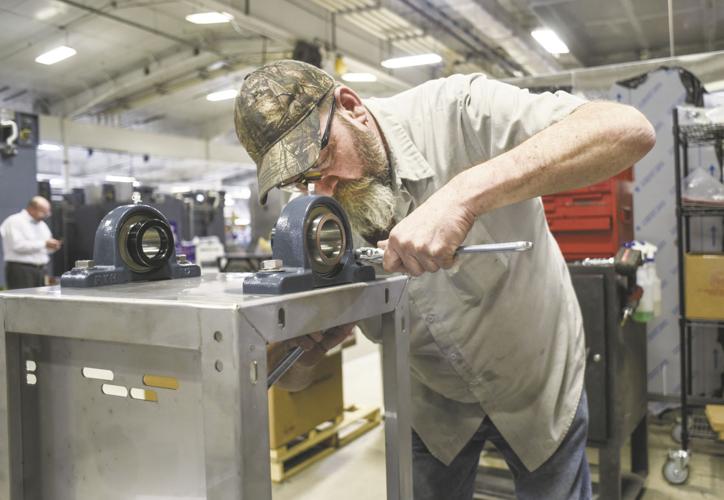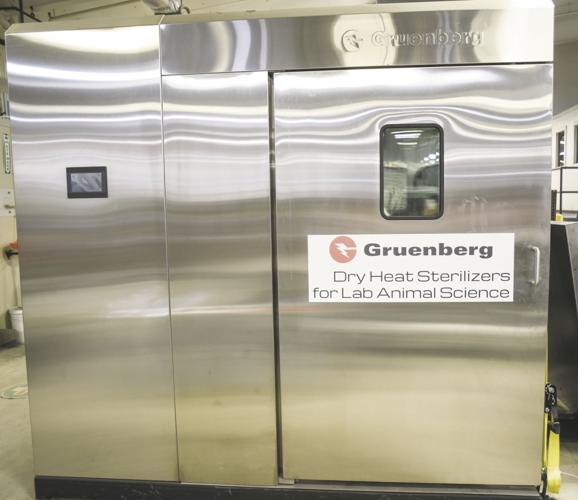The COVID-19 pandemic bolstered a thriving and healthy community of manufacturers in Central Pennsylvania because they had a history of preparing for worst-case scenarios in the economy.
A majority of Valley manufacturers did not experience supply chain issues during the early days of the pandemic because they routinely stock up on needed supplies, said Christine Ngo, assistant professor of economics, Bucknell University.
Additionally, many Valley manufacturing companies did not, and still don’t carry a heavy debt load, which enables them to be flexible when needed.
The manufacturing issues plaguing the U.S. and the globe — from baby formula to fertilizer — haven’t had as great an impact locally, Ngo said. There has been some impact, including employee shortages, she said.
“It simply was not the issue in Central Pennsylvania,” she said.
“I also did not see a lot of corporate debt here. This is unique to Central Pennsylvania. Companies stock up on their supplies, so they were ready for anything.”
In Central Pennsylvania, manufacturing is responsible for 40,408 full-time jobs, according to research by the Innovative Manufacturers Center (IMC), of Williamsport. The payroll generated by local manufacturers is $2.1 billion.
Key manufacturing industry clusters include metal manufacturing, food processing, lumber products, plastics, energy and logistics.
Top manufacturing employers in Central Pennsylvania include Restek, Bellefonte; Ritz-Craft Corporation of Pennsylvania, Mifflinburg; Weis Markets; Con Agra Foods in Milton; Wise Foods, Berwick; Great Dane, Danville; Conestoga Wood Specialties, Beavertown.
Central Pennsylvania manufacturers are very conservative when it comes to supply, Ngo said, and that helped during the economic downturn caused by COVID-19.
Before the pandemic, supplies and raw materials were put in warehouses so they could weather the rainy days.
Good relationships and long-standing relationships with suppliers are another positive with Central Pennsylvania manufacturers.
The relationships are intimate and because of that, they overcome shortages. They called suppliers when they were running low and those needs were addressed.
“This is the way America was running before globalization happened in the 1980s,” Ngo said.
This gave them the resilience to survive the pandemic. Companies have gone through so many downturns they know there will be another one so they stock up, she said.
Dennis Gilbert, IMC president, agreed with Ngo.
“Most of the manufacturing sector in Central Pennsylvania is doing well, in terms of business opportunities. Largely, manufacturing is spiking to the positive,” he said.
There are a couple of reasons for that, Gilbert continued, “and one of them is the idea of near-shoring. Because of supply chain issues, people have elected to contract with various manufacturers closer to where their operation is. That’s a trend that we are seeing as a result of the supply chain issue.”
Another reason local manufacturers have largely weathered the choppy waters of the pandemic is that they cushioned themselves with a lot of finances, Ngo said.
“So when they went into the pandemic they were pretty resourceful and cushioned themselves,” Ngo said. “COVID played a pretty big role in the whole scheme of things.”
Industrialization and outsourcing have prompted manufacturers in Central Pennsylvania to find a way to survive throughout COVID, using numerous different adaptations and activities.
“Given the prolonged period, some did experience turbulence due to COVID, but many of them found themselves in the right positioning going into the pandemic, and my expectation, coming out of the pandemic, the supply chain crunch,” Ngo said. “We are entering a period of de-globalization, so there will be a lot of opportunities for our regional manufacturers.”
COVID created a lot of changes and those companies that survived had gone through a lot of adaptations the last three years. and with those adaptations, Ngo said, they are well-positioned to take up the opportunities coming at them in the coming decade.
“These manufacturers should find a major demand for their products domestically,” she said. “On the policy front, the government is reorienting manufacturing back to the U.S. The infrastructure plan by itself should also create a huge amount of demand.”
There is also government policy that favors bringing back manufacturing to the U.S. and then there is this global structural change in the supply network that is also favorable for regional manufacturers.
“The pandemic was very good for some manufacturers,” she said. “The shortage of wood supplies. There was a period of two years when lumber was in huge demand and Central Pennsylvania is pretty well located for manufacturing of lumbers of all kinds, from raw materials to almost finished product.”
Oil and gas is also in huge demand now and Central Pennsylvania is producing a lot of that.
Ngo interviewed a company, Thermal Product Solutions (TPS), of New Columbia, that produces industrial ovens, and commercial ovens. There was also a demand for TPS to sanitize ovens during the pandemic, so they experienced a large demand for products.
This area has a huge amount of agriculture, but there is a misunderstanding about agriculture in this area. It requires an enormous amount of labor, but in terms of revenue, it is not a dominant sector.
The barriers that remain in place are similar to those in areas that struggle with the pandemic and supply-chain issues.
“The biggest barrier at this point,” Ngo said, “is labor. The labor shortage is getting worse, much worse compared to a year ago, and it was already very bad before the pandemic.”
Gilbert said labor is a big challenge for companies, in all sectors of industry.
“There are a lot of reasons behind that,” he said. “Ironically, if you look at the data, you would see a trend of the declining workforce even prior to the pandemic. The pandemic probably accelerated an already occurring problem. The labor pool is causing some of that shift.”
There is a concentration of labor in urban areas — people want to move there because they expect better pay and a good quality of life. Better opportunities to move up the ladder, Gilbert and Ngo said.
“We have wonderful workers here,” Ngo said. “We just don’t have enough of them.”
and then the pandemic made things worse.”
Female workers had to leave the market to take care of their families. and then there was a huge demand for manufactured products here and companies cannot find new laborers overnight to meet their needs.”
“Every manufacturer I spoke to complained they can’t find workers. and it has become a huge constraint for them. They have machines. They can run it 24/7 but just don’t have the workers to operate the production.”
Solutions
Experts have been tasked with trying to find a solution.
“Some say we innovate our way out of this problem,” Gilbert said. “We use advanced technology, we train more people. That could help but the main problem is we don’t have enough people in the U.S. workforce.”
The short-term solution to the labor problem, the only solution, Ngo insisted, is to increase pay. To attract those who are not available to work for whatever reason to return to the labor market. That’s why we’ve seen some wage increases in the last couple of quarters. It’s the only way to attract workers to come back.
Salaries in this industry are variable, Gilbert said, especially with overtime.
“There are many in manufacturing jobs as supervisors with salaries in the six-figure area, but they are typically worked a fair amount of OT,” Gilbert said. “I hear starting wages with zero experience at around $19-21 per hour.
“In the long term, we need to confront the structural problems of why the U.S. has such a large percentage of workers who are not available to work. We call them discouraged workers.”
According to the data, Gilbert said, a large percentage of workers “are discouraged — one of the highest percentages of discouraged workers in the developed world.”
Gilbert explained why so many working-age workers are not willing to enter the workforce. Some reasons are structural: They don’t have the transportation, they don’t have the skills, they don’t know a way to find jobs, they might have some family issues, extreme poverty, maybe some have mental health issues, drug addiction issues that prevent them from going back into the labor market.
Unless we confront those issues the labor shortage will continue for quite some time, Ngo added.
Employers are being creative, and in some cases are hiring immigrants in urban centers and providing them with a good salary to entice them to move into rural areas.
“That’s the irony,” Gilbert said. “What might solve the problem is immigration, but that’s become such a political issue these days. Our borders are a hot topic. But studies show that immigration can help solve the problem of not having a sufficient pool of laborers.”
Employers are trying really hard. But everyone is competing for workers.
Employers could also provide job training, Gilbert said.






